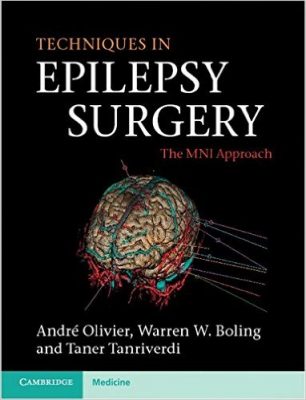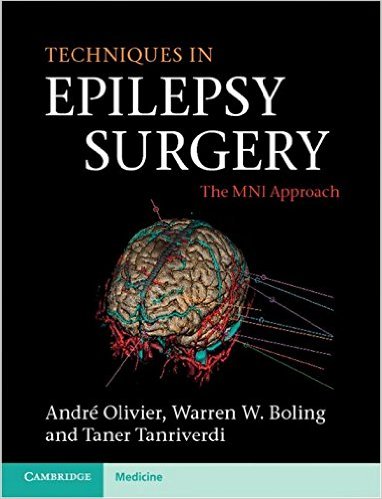 Authors: Andre Olivier, MD; Warren W. Boling, MD; and Taner Tanriverdi, MD
Authors: Andre Olivier, MD; Warren W. Boling, MD; and Taner Tanriverdi, MD
Publisher: Cambridge University Press – 287 pages
Book Review by: Nano Khilnani
Epilepsy is one of several neurological diseases in the brain that cause seizures. Some seizures are short while others involve long periods of shaking. The seizures often recur and seem to have no immediate underlying cause.
For most cases of epilepsy the causes are unknown (so far). But people can develop epilepsy after a brain injury, a stroke, infections in the brain, the development of a tumor, or a birth defect. Some known genetic mutations are also linked to a small number of epileptic seizures.
Abnormally excessive nerve cell activity in the cortex of the brain (which can be seen with brain imaging) results in epileptic seizures. The neurologist typically finds out what is associated with the seizures. It could be alcohol withdrawal or electrolyte problems that is related to the seizures.
Epilepsy that occurs as a result of some verifiable causes can be prevented. Seizures can be controlled about 70 percent of the time with medication. But when drugs cannot stop seizures, surgery is the next available option. This is a book about epilepsy surgery written by the three people named above. We provide you below the titles of its chapters:
- History of epilepsy surgery
- The search for the epileptic focus: investigation of the surgical candidate
- Surgical anatomy
- Neuro-navigation and preoperative brain mapping
- Stereoelectroencephalography (stereotactic intracranial recording)
- Anesthesia and awake procedure
- Preoperative brain mapping
- Endopial resection (intervascular endopial gyral emptying)
- Surgery of temporal lobe epilepsy: cortico-amygdalohippocampectomy
- Surgery of temporal lobe epilepsy: transcortical selective amygdalohippocampectomy
- Surgery of central area epilepsy
- Surgery of frontal lobe epilepsy
- Surgery of parietal lobe epilepsy
- Surgery of insular lobe epilepsy
- Surgery of occipital lobe epilepsy
- Hemispherectomy
- Callostomy
- Epilepsy and brain tumors
- Surgical treatment of cortical dysplasias
- Reoperations in failed epilepsy surgery
- Alternative procedures in surgery for epilepsy
- Complications of epilepsy surgery
- Quality of life after epilepsy surgery
Over 2,500 surgical procedures for the treatment of intractable epilepsy had been performed by the senior author – Dr. Andre Olivier – at the Montreal Neurological Institute and Hospital by the year 2005. He writes about this in the Preface, and gives credit to his mentor Dr. Theodore Rasmussen for teaching him the surgical approaches, techniques of brain mapping, and cortical resections.
It was a period during which microsurgery and image-guided surgery greatly helped improve neurosurgical work, especially as they related to extracerebral vascular and tumoral lesions. Dr. Olivier writes that he and other neurosurgeons “made a constant effort” to apply the techniques to the intragyral endopial resection.
In this book on surgical techniques as they relate to epilepsy surgery, the authors emphasize the importance of mastering the trilogy of topographic, vascular and functional anatomy of the brain. It is a good guide for neurosurgeons who practice or plan to specialize in epilepsy surgery.
In it the authors state that surgical skills alone are not sufficient for successful outcomes. Knowing and doing the patient-selection process thoroughly is also critical, as well as possessing the skills to communicate clearly with the patient and teaching them the basic relevant anatomy of the area that is going to be operated on.
The surgeon must also know not only of the expected benefit from the surgical procedure but also the possible pitfalls of surgery such as:
- Eventual impact of surgery on memory, motor function, speech, and vision
- False diagnosis of functional areas
- Irrelevant lesions
- Wrong diagnosis
On the bright side, the authors point out that epilepsy surgery has benefited from technological advances, such as:
- Around 1971, video monitoring by John Ives: a major breakthrough
- Advent of MRI in 1985 enabling detection of a large variety of lesions and their topographic relationships to eloquent areas of the brain
- Computer seizure detection
- Development of modern recording techniques
- Neuro-navigation: computer-image guidance to microsurgical techniques, making it possible to detect virtually any epileptogenic lesion in any area of the brain
- PET scanning, fMRI, and spectroscopy
Andre Olivier, MD is W. Cone Professor and Chairman of the Division of Neurosurgery at McGill University; and Neurosurgeon-in-Chief at Montreal Neurosurgical Institute and Hospital, and McGill University in Montreal, Quebec, Canada.
Warren W. Boling, MD is Professor in the Department of Neurosurgery at the University of Louisville, in Louisville, Kentucky.
Taner Tanriverdi, MD is Assistant Professor in the Department of Neurosurgery in Cerrahpasa Medical Facility at Istanbul University in Istanbul, Turkey.







